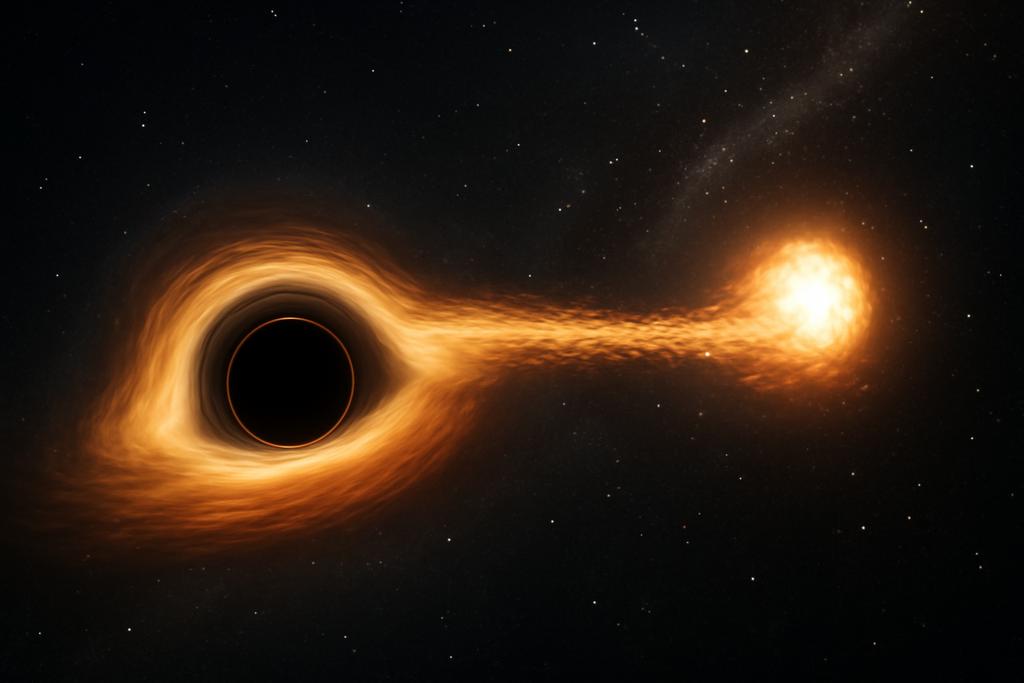Imagine a cosmic game of peek-a-boo, where the players are supermassive black holes and unsuspecting stars. A new AI system, developed by researchers at several universities including Swinburne University of Technology, led by Miguel Llamas Lanza and Sergey Karpov, is making this celestial hide-and-seek a bit less mysterious. It’s able to detect when a star gets too close to a black hole and begins to be devoured, a process known as a tidal disruption event (TDE), significantly earlier than ever before.
The Cosmic Feast
TDEs are dramatic events. As a star wanders too close to the gravitational behemoth of a supermassive black hole, the black hole’s immense tidal forces begin to stretch and shred the star, creating a fiery spectacle. This celestial ballet results in a burst of radiation, a cosmic feast for our telescopes. These events are relatively rare, occurring at a rate of about 10-5 per galaxy per year, making them scientifically precious but hard to catch in the act.
Finding Needles in a Cosmic Haystack
Large-scale optical surveys, like the Zwicky Transient Facility (ZTF) and the upcoming Vera C. Rubin Observatory Legacy Survey of Space and Time (LSST), monitor the sky for transient events — sudden changes in brightness. This search is akin to looking for a few rare, brightly colored needles in a colossal haystack. These surveys produce massive streams of data, requiring ingenious algorithms to separate the interesting signals from the noise.
The challenge is not just the sheer volume of data, but also the fact that TDEs, especially in their early stages, look similar to other transient phenomena, like supernovae or outbursts from active galactic nuclei (AGNs).
Early Warning System
The researchers developed a new AI module integrated into the Fink alert broker, a system that processes astronomical data in real time. This module focuses on identifying the telltale signs of a TDE during its rising phase—before the star is fully devoured and before the black hole’s meal becomes maximally bright. The key is looking at light curves—plots of how the brightness of an object changes over time—and extracting features that help distinguish a TDE from similar events. This involves fitting simple models to the rising light curves, using tools like Rainbow, and then using the resulting parameters as features for a sophisticated machine-learning algorithm called XGBoost.
More Than Just a Classifier
This AI isn’t just about classifying known TDEs; it’s about discovering new ones, and doing so early. The team trained their AI on a relatively small number of known TDEs, a testament to their innovative approach to machine learning, enabling the system to generalize effectively from limited data. This is like teaching a child to recognize cats based on a handful of examples and then having them confidently identify a diverse range of felines.
The results are impressive. The AI achieves a remarkable 76% recall, meaning it identifies a large fraction of TDEs—a noteworthy achievement considering the challenges of early detection. Moreover, by applying the algorithm to archival data, the researchers discovered several potential new TDEs, including a likely repeated TDE and some potential TDEs occurring in active galaxies.
Looking Ahead to the Rubin Observatory
The implications of this work are significant. As the LSST comes online, it will generate an even larger flood of data, making automated, efficient tools like this essential. The current system is tailored to ZTF data, but the plan is to adapt it for the LSST, which will likely require more refinements to keep the volume of candidates manageable for human review. The researchers envision using simulated data initially, then retraining the algorithm with real observational data as it becomes available.
Beyond the Data
This research highlights the growing synergy between cutting-edge AI and astronomy. Machine learning isn’t just assisting astronomers; it’s becoming an essential partner in discovery. By enabling earlier detection of TDEs, this AI provides crucial time for follow-up observations, leading to a deeper understanding of these remarkable cosmic events and the supermassive black holes at their centers. It’s a step forward in our quest to unravel the mysteries of the universe, one stellar snack at a time.










